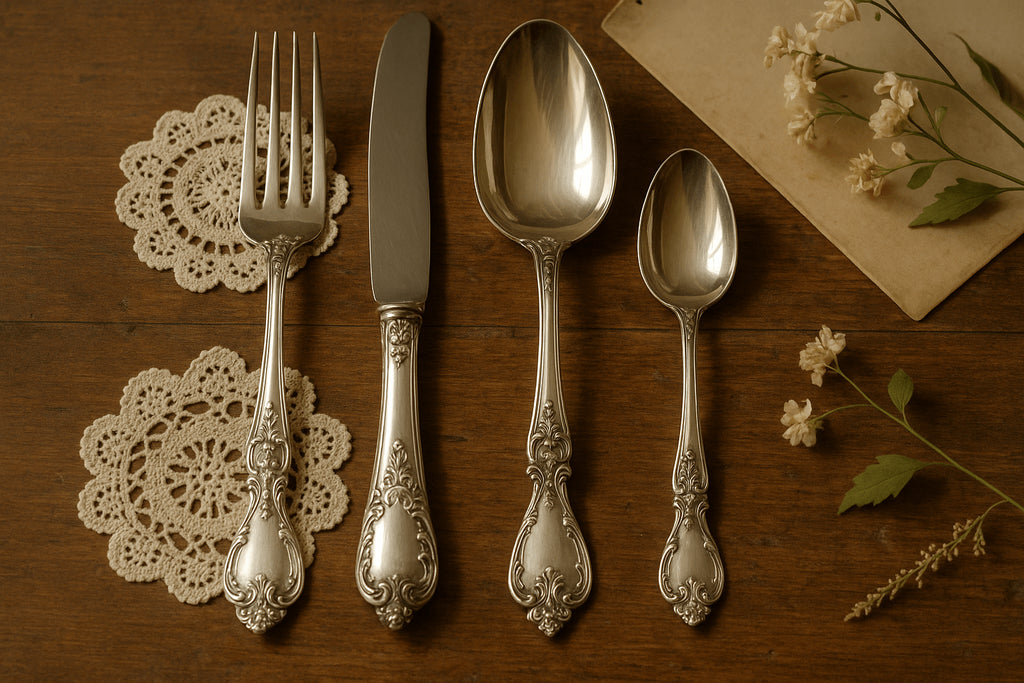Antique silver cutlery handle patterns
Posted by WATANABETAIGA

Antique silver cutlery is not only a tool for eating, but also an item that reflects the craftsmanship and food culture of the era in which it was made.
In particular, there are many different handle designs (patterns), each with its own origin and characteristics.
The pattern can help us to guess the year of manufacture and country of origin to some extent, and it can also give us insight into the background of how the design was created.
In this article, we will focus on handle patterns on antique cutlery, explaining their history and characteristics, from basic British patterns to decorative designs, and even patterns found in countries other than the UK, such as France and the US.
1. Antique British cutlery handle patterns
The habit of using cutlery spread throughout Europe when Catherine de' Medici, a member of the Medici family, invited Florentine chefs to the French court in the 16th century, bringing cutlery along with refined food culture.
Until the early 18th century, French-style cutlery was the mainstream in British cutlery design, but from around the 1750s, uniquely British designs began to emerge and changed significantly from the 18th to the 19th century.
During this period, with the development of industry, a middle class emerged and the demand for silverware increased.
This demand is thought to be one of the factors that encouraged silversmiths to develop a wide variety of designs.
Early designs: "Hanoverian" and "Old English"
The "Hanoverian pattern" was established as a uniquely British pattern in the mid-18th century. The name comes from the House of Hanover, the royal family at the time.
The design is simple, with the tip of the handle curving in the same direction as the spoon's bowl (the dish-shaped part at the tip), and the cross section being rounded. Many of them have a reinforcing protrusion called a "rat tail" on the back of the base where the bowl joins.
From around the 1770s, the "Old English pattern" became popular.
In contrast to the Hanoverian, the tip of the handle is curved backwards.
At the time, the style of placing spoons with the bowls upside down was becoming increasingly common for table settings, and this position was preferred as it allowed the curve of the handle to look beautiful.
The Old English pattern, with its simple, balanced shape, was produced for a long time and became established as one of the basic designs of British cutlery.

(Hanoverian *Top 2 points, Old English *Bottom 4 points)
-Added decoration: "Fiddle" and its variations
In the 19th century, there was a demand for more decorative designs.
The "fiddle pattern" was born in response to this.
This pattern, with its narrow handle at the base and flared tip, was named for its resemblance to a fiddle, a stringed instrument, and also served as a basis for further decoration.
Several variations were made, including the "Fiddle & Thread" with engraved lines on the edge of the handle, the "Fiddle & Shell" with a shell motif on the tip, and a combination of both called the "Fiddle, Thread & Shell."
These decorations also indicated the owner's taste and financial status.

2. "Kings Pattern" and "Queens Pattern"
Among the many British cutlery patterns, the "King's pattern" and "Queen's pattern" are particularly luxurious and popular.
Both designs originated in early 19th century Britain and were popular throughout the Victorian era of the 19th century.
The "Kings Pattern" is said to have been first created in the 1820s by British silversmith George Adams (a member of Chawner & Co.).
He was born during the Regency era under King George IV, a man of extravagant tastes and a penchant for the arts.
The design is based on the fiddle pattern, but is more substantial and intricately decorated, and the top and bottom of the handle are carved with three-dimensional motifs of acanthus leaves, honeysuckle arabesques, and shells, which are found in ancient Greek and Roman architecture.

(King's Pattern)
The "Queen's Pattern" appeared a little later than the King's Pattern and is a more elegant and delicate design.
The basic motif is the same as the King's pattern, but the major difference is that the honeysuckle pattern includes small circular decorations called "rosettes" that resemble floral medals.
Many of them also have a small ball on top of the shell motif at the end of the handle.
The overall design has more detailed and three-dimensional carvings, giving it a feminine and elegant impression.

(Queen's Pattern)
The difference between these two patterns is very subtle, so it may be difficult for beginners to tell the difference.
A good way to remember this is that if there is a rosette in the honeysuckle pattern, it is called a "Queen's pattern," and if there is not, it is called a "King's pattern."
3. Non-British Handle Patterns
Cutlery design has developed independently in various countries outside of Britain.
·France
French silver cutlery developed earlier than in Britain, around the 17th century, but the French Revolution in the 18th century resulted in many of the aristocrats' silverware being melted down, making pre-revolutionary items rare.
Antique French cutlery is characterised by its elegant and intricate design.
Influenced by the Rococo and Neoclassical styles, many of the designs feature motifs such as ribbons and garlands.
During the Art Nouveau period at the end of the 19th century, companies such as Christofle produced products with curved designs featuring plant and other motifs.

·America
The American silverware industry grew significantly in the second half of the 19th century.
In the early days, British designs were used as a reference, but gradually the brand began to develop its own patterns and produce a diverse range of designs that do not stick to traditional European styles.
Manufacturers such as Tiffany and Gorham each released a number of original patterns.
In particular, many decorative designs were created that realistically depicted flowers and plants.

·Germany
German cutlery is generally simple in design and focuses on functionality.
On the other hand, there are also decorative patterns that use specific motifs, such as the "Hildesheim Rose", which is said to have originated in the town of Hildesheim.
This is based on the legendary rose associated with the city's cathedral, and is designed so that a single rose covers the entire handle.

summary
The handle patterns of antique cutlery are not simply designs; the designs themselves have meaning and are linked to the technology, culture, and trends of the era in which they were produced.
The British "Old English" shape is related to the table manners of the time, while the luxurious decoration of the "King's Pattern" reflects the social conditions of the Victorian era.
Similarly, the patterns of France, America, Germany, etc. reflect the culture and historical background of each country.
When observing antique cutlery, paying attention to the handle designs will help you to enjoy it even more.











